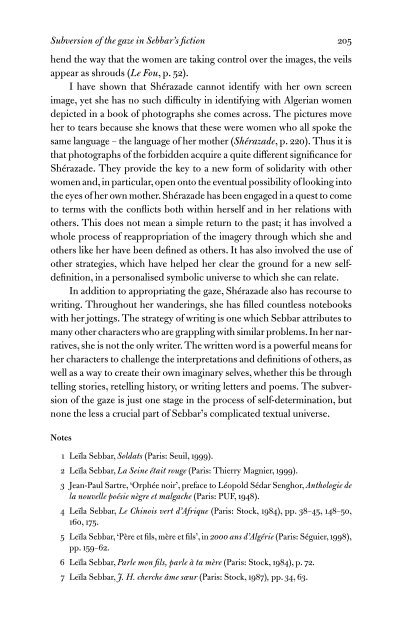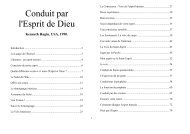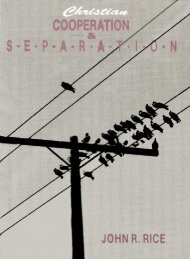Women writing in contemporary France
You also want an ePaper? Increase the reach of your titles
YUMPU automatically turns print PDFs into web optimized ePapers that Google loves.
Subversion of the gaze <strong>in</strong> Sebbar’s fiction 205<br />
hend the way that the women are tak<strong>in</strong>g control over the images, the veils<br />
appear as shrouds (Le Fou,p.52).<br />
I have shown that Shérazade cannot identify with her own screen<br />
image, yet she has no such difficulty <strong>in</strong> identify<strong>in</strong>g with Algerian women<br />
depicted <strong>in</strong> a book of photographs she comes across. The pictures move<br />
her to tears because she knows that these were women who all spoke the<br />
same language – the language of her mother (Shérazade,p.220). Thus it is<br />
that photographs of the forbidden acquire a quite different significance for<br />
Shérazade. They provide the key to a new form of solidarity with other<br />
women and, <strong>in</strong> particular, open onto the eventual possibility of look<strong>in</strong>g <strong>in</strong>to<br />
the eyes of her own mother. Shérazade has been engaged <strong>in</strong> a quest to come<br />
to terms with the conflicts both with<strong>in</strong> herself and <strong>in</strong> her relations with<br />
others. This does not mean a simple return to the past; it has <strong>in</strong>volved a<br />
whole process of reappropriation of the imagery through which she and<br />
others like her have been def<strong>in</strong>ed as others. It has also <strong>in</strong>volved the use of<br />
other strategies, which have helped her clear the ground for a new selfdef<strong>in</strong>ition,<br />
<strong>in</strong> a personalised symbolic universe to which she can relate.<br />
In addition to appropriat<strong>in</strong>g the gaze, Shérazade also has recourse to<br />
<strong>writ<strong>in</strong>g</strong>. Throughout her wander<strong>in</strong>gs, she has filled countless notebooks<br />
with her jott<strong>in</strong>gs. The strategy of <strong>writ<strong>in</strong>g</strong> is one which Sebbar attributes to<br />
many other characters who are grappl<strong>in</strong>g with similar problems. In her narratives,<br />
she is not the only writer. The written word is a powerful means for<br />
her characters to challenge the <strong>in</strong>terpretations and def<strong>in</strong>itions of others, as<br />
well as a way to create their own imag<strong>in</strong>ary selves, whether this be through<br />
tell<strong>in</strong>g stories, retell<strong>in</strong>g history, or <strong>writ<strong>in</strong>g</strong> letters and poems. The subversion<br />
of the gaze is just one stage <strong>in</strong> the process of self-determ<strong>in</strong>ation, but<br />
none the less a crucial part of Sebbar’s complicated textual universe.<br />
Notes<br />
1 Leïla Sebbar, Soldats (Paris: Seuil, 1999).<br />
2 Leïla Sebbar, La Se<strong>in</strong>e était rouge (Paris: Thierry Magnier, 1999).<br />
3 Jean-Paul Sartre, ‘Orphée noir’, preface to Léopold Sédar Senghor, Anthologie de<br />
la nouvelle poésie nègre et malgache (Paris: PUF, 1948).<br />
4 Leïla Sebbar, Le Ch<strong>in</strong>ois vert d’Afrique (Paris: Stock, 1984), pp. 38–45, 148–50,<br />
160, 175.<br />
5 Leïla Sebbar, ‘Père et fils, mère et fils’, <strong>in</strong> 2000 ans d’Algérie (Paris: Séguier, 1998),<br />
pp. 159–62.<br />
6 Leïla Sebbar, Parle mon fils, parle à ta mère (Paris: Stock, 1984), p. 72.<br />
7 Leïla Sebbar, J. H. cherche âme sœur (Paris: Stock, 1987), pp. 34, 63.


















